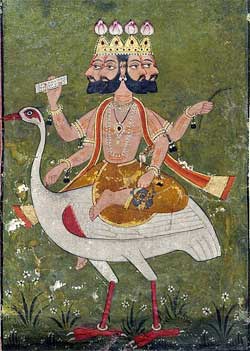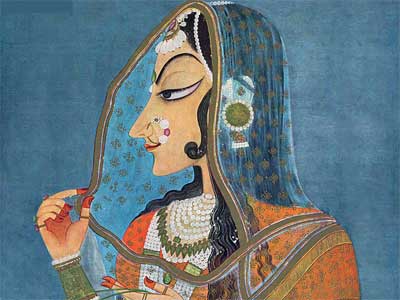Concert
Zakir Hussain, tabla
Niladri Kumar, sitar
Dilshad Khan, sarangi
V. Selvaganesh, kanjira and ghatam
Vijay S Chavan, dholki
Deepak Bhatt, dhol
Steve Smith, drums
For details on the musicians, please see:
Up and Coming: Zakir Hussain and the Masters of Percussion.
World Music/CRASHarts
Symphony Hall, Boston, MA
April 6, 2014
7:00 pm

Northern India, c. 1700
Museum of Fine Arts, Boston
It began subtly, in the dark, with a little tapping from Selvaganesh Vinayakram on the ghatam, the clay pot. Gradually it built in intensity and Selvaganesh was joined by Dilshad Khan on the sarangi , a small, boxy, bowed string instrument, and somewhat afterwards by Zakir Hussain on the tabla.
There was a very long stretch when Khan bowed a simple sequence repetitively while Hussain meandered around for rhythms and apparent coordination with Khan. The experimentation of that sequence seemed endless, a bit trying to take in throughout its distinctive tenure, but it too finally built into a masterfully rhythmic and coherent whole, with both Hussain’s tabla and Khan’s sarangi reverberating with incredible virtuosic velocity.
Selvaganesh’s father, Vikku Vinayakram, played the clay pot on the original Shakti albums from the mid-1970s in which Zakir Hussain also appeared along with John McLaughlin on guitar and L. Shankar on violin. Selvaganesh is a master on the instrument, a true heir to his father’s remarkable musical legacy, and is also a master on the kanjira, a small flat hand drum that looks something like a tambourine without the cymbals, doing more with a single hand and a simple surface than one could easily imagine were possible.
The ease of approach, the languorous prelude, the seeming desire to warm the hands of the players and the ears of the listeners are all striking – nothing is rushed, and much patience is exhibited as forms take shape.
When it all falls into place, however, watch out. The hands move faster than one can believe, and out of what look like simple drums emerge the most varied collections of sound.
Nilandi Kumar, on the sitar, came in equally relaxed in the angle of approach, and gradually built up to a mad escapade of movements that eventually moved blindingly before one’s eyes and filled one’s ears with cascades of melody.

Kishangarh, Jaipur, Rajasthan
18th century
At one point, Hussain, who draws more sounds of the tabla than one can imagine, did a fabulously amusing, as well as fascinating, riff on scenes captured from an Indian traffic jam. It was such a vivid set of images – about trucks and motor scooters, goats and cows – that gave a wonderful narrative life to the music forms he illustrated with them. It was vivid, significant and truly hilarious.
Vijay S. Chavan, on the small cylindrical side drum, the dholki, also drew out cascades of riffs with a pair of sticks.
Steve Smith, the American addition to the group, started out with a single hi-hat cymbal doing all kinds of things with a pair of sticks, drawing luminous and subtle effects from the hi-hat and its various supports. He also did an incredible gymnastic trick with drumsticks clicking and bouncing off his arms, occasionally flying into flips in the air. It was magical. Smith was also great at keeping up with the Indians on the rapid and rhythmic vocalized patterns that sometimes accompanied the instrumental parts, impressive all around.
In the second half, Deepak Bhatt came out of the back of the auditorium with a fanfare from his wide cylindrical drum, the dhol, which led gradually to the accretion of one instrument after another until practically all the instrumentalists were together onstage, giving their rhythmic all. It is hard to describe the exhilaration that emerged from this electrifying collection of flying hands, and when, with a precise calculation of the final synchronized riffs, the entire group drew the fabulously rich fanfare to a close, the audience literally leapt to its feet.
I have had the great pleasure of hearing Zakir Hussain numerous times over the years – with Shakti years back, and then with other Indian percussionists years later. He is a master of his instrument, seemingly transported to a state of concentrated abandon when playing, and he is a generous sponsor of this group of masterful musicians each of whom, in turn, displays miraculous dexterity and grace. The aggregate result is dramatic and energizing, building from its patient and quiet beginnings to its fantastic climax.
– BADMan
Leave a Reply